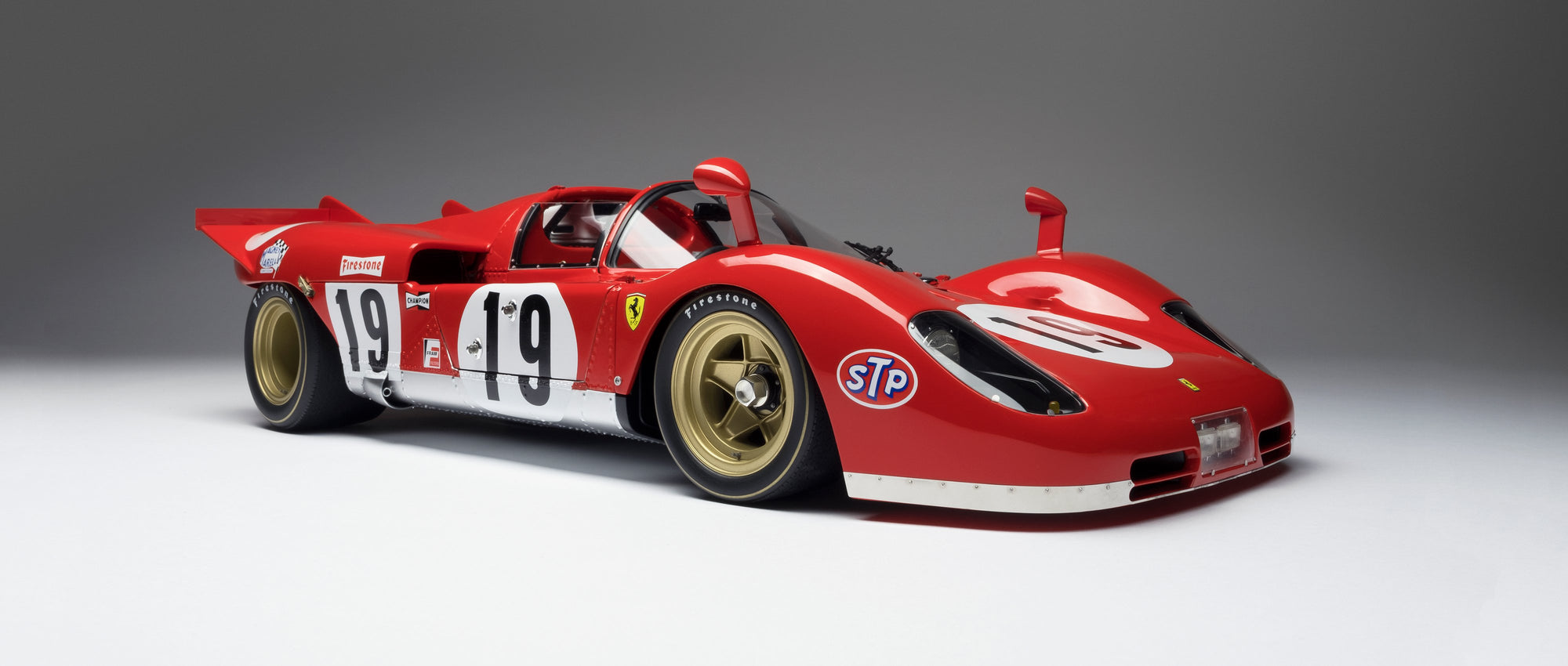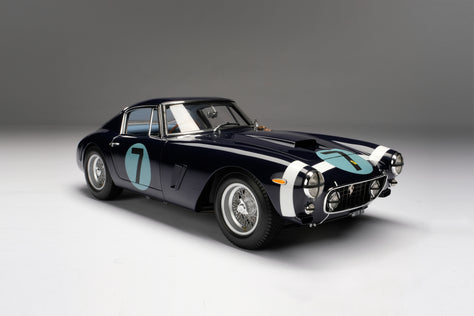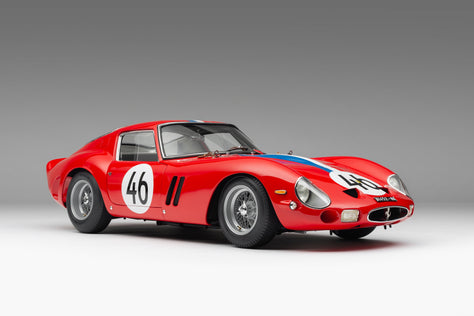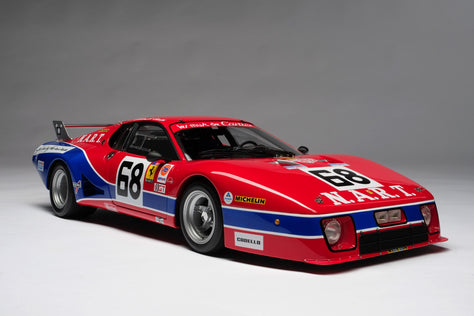Technical Details
- Description
- Scale guide
Designed and built in just three months by a team headed by Mauro Forghieri, the Ferrari 512 S was to be Ferrari’s entry in the new 5-litre class sports-prototype for the 1970 and 1971 World Sports Car Championship seasons. To obtain type-approval for the model, 25 units had to be built, and Enzo Ferrari sold 50% of his company to Fiat to finance the project.
The car was built around a tubular light-alloy semi-monocoque frame, derived from the P4 and the 612 CAN AM, with a mid-mounted 4993 cc V12 engine, with four valves per cylinder, capable of delivering 550 hp initially, with a maximum speed of 340 km/h. The bodywork, designed by engineer Giacomo Caliri, was constructed from fibreglass and designed to be as light as possible. The 512 S was built both with a closed cockpit and in an open top, and a special long-tail aerodynamic body was created for its races at Le Mans.
The 512 S made its debut in the 1970 Daytona race, taking third place with Mario Andretti, Arturo Merzario and Jacky Ickx behind the wheel. The car scored its first win at the following race, the 12 Hours of Sebring, with Ignazio Giunti, Nino Vaccarella and Andretti driving the closed version of the 512 S, defeating the Porsche 908 of Peter Revson and Steve McQueen. Throughout the rest of the season, the duel continued between Ferrari and the Porsche, who raced primarily with their 917K prototype, with Porsche usually emerging the victor. Chris Amon and Merzario finished fifth in the 1000km of Brands Hatch, while in the 1000 km of Monza, 512 S cars claimed second, third and fourth places. Vaccarella and Giunti fought their way onto the third step of the podium in the Targa Florio and claimed fourth at the 1000 km of Spa. Ickx and John Surtees also claimed second position at Spa, before succeeding in another podium at the 1000km Nürburgring. Andretti and Giunti took third place with Ickx and Peter Schetty fifth at the 6 Hours of Watkins Glen. Throughout the year, several private teams did score several successes in other competitions, such as Georg Loos and Helmut Kelleners at the 500 km of Zolder in Belgium and Gianpiero Moretti at the 200 Miles of Fuji in Japan.
A modified version of the 512 S, called the 512 M, made its debut in the wake of Ferrari’s poor showing at Le Mans, where cars could only claim fourth and fifth. This car, with greater power and more advanced aerodynamics than the 512 S gave Ickx/Giunti a win in the 9 Hours of Kyalami. However, Enzo Ferrari did not have the patience to continue developing this model and relegated the 512 M for use by private teams only.
For the 1971 season, Ferrari switched their attentions back to three litre sports models and would soon dedicate itself to Formula 1 racing for the next two decades. Both the 512 S and the 512 M continued to achieve good results in the hands of the privateers, with the NART team’s 512 S and the Penske team’s blue 512 M finishing in second and third place in Daytona. Merzario won the 300 km of Imola in the only official works appearance of the 512 M in 1971.
This fine 1:8 scale model of the Ferrari 512 Spyder as raced in the 12 Hours of Sebring by Nino Vaccarella, Ignazio Guinti and Mario Andretti at Sebring International Raceway on the 21st of March 1970. Considered by many to be the most memorable 12 Hours of Sebring ever held, this 12th edition of 1970 proved to be drama-filled to the last. Porsche had emerged victorious at Daytona just seven weeks prior, but Andretti qualified the #19 car on pole position, giving Ferrari a small but early advantage. Two other works Ferraris entered, #21 of Ignazio Giunti and Nino Vaccarella and the #20 of Jacky Ickx and Peter Schetty.
After a rolling start, a first for Sebring, Andretti held onto the position until the first round of pits stops and drive changes. Porsche’s four 917K entries started to experience problems, one with electrical issues, another with a puncture. Another entry retired with irreparable suspension damage, leaving all three works Ferraris with the lead as the sun set. Fortunes changed switched during the night, the #20 Ferrari suffered from a blown head gasket, retiring after 151 laps, and problems were plaguing the #21 car which necessitated a long pit stop. Then, Andretti brought the leading #19 car into the pits with gearbox issues. Though Merzario returned the car to the track in the lead, the #15 Porsche 917K of Pedro Rodriguez and Jo Siffert was gaining rapidly. The strain on the mechanics started to show, and the #19 quickly returning to the pits again, this time not to return. Porsche was on course for another 1-2 victory, with the 917K leading the way and the Solar Productions/Gulf sponsored #48 Porsche 908/02 of movie star and racer Steve McQueen, who was racing with his leg in a cast, and Peter Revson in second.
With half an hour remaining, one car still running and desperate for an overall victory, Ferrari team manager gambled, calling in Giunti in the #21 car and replacing him with the faster and more experienced Andretti. Starting a lap down, Andretti was fantastic, unlapping himself quickly and piling the pressure on the Porsches ahead. Suddenly, the leading Porsche came into the pits with a front hub failure, ultimately retiring just four laps from the end of the race, promoting McQueen and Revson’s 908 into first position. Andretti promptly overtook Revson, but returned to the pits once more, this time for a fuel stop, giving the lead back to the Porsche. With just one lap to go, Andretti stormed back onto the track and chased down his rival, finishing the 248th and final lap just 22 seconds ahead after twelve hours of competitive racing.
The Ferrari 512 S is limited to just 199 pieces.
Pre-order
Bespoke
In order for us to create your bespoke model, you will need to choose 4 extra options. Paint colour, interior colour, wheel style and caliper colour.
Please complete the form and a member of our Sales Team will contact you.
Contact Us
Please contact us for more information about ordering this model.






